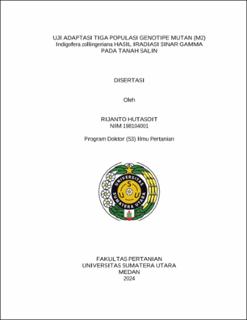| dc.contributor.advisor | Purba, Edison | |
| dc.contributor.advisor | Ginting, Simon P | |
| dc.contributor.advisor | Hanafi, Nevy Diana | |
| dc.contributor.author | Hutasoit, Rijanto | |
| dc.date.accessioned | 2025-05-28T08:55:24Z | |
| dc.date.available | 2025-05-28T08:55:24Z | |
| dc.date.issued | 2024 | |
| dc.identifier.uri | https://repositori.usu.ac.id/handle/123456789/104216 | |
| dc.description.abstract | Indigofera zollingeriana is a legume plant that is cultivated as a feed crop in Indonesia. Ruminant livestock have a high preference for this plant, so it is consumed well to stimulate livestock growth performance. The high interest of farmers in developing it is constrained by land availability. One alternative that can be done is to expand livestock areas toward marginal land. This research aims to examine how the growth of three population genotypes mutant (M2) I. zollingeriana results from gamma-ray irradiation on saline soil and the factors that influence changes in plant characteristics. The design used in this research was a randomized block design (RBD) using M2 I. zollingeriana materials resulting from gamma ray irradiation (100, 200, and 300 gray) and 0 gray with six replications. The results showed differences in leaf and flower morphology, with the highest number of leaflets at the 200 Gy level (11443.76 strands). Superior leaf width at a dose of 100 Gy (11.23 cm). The highest number of flowers was 32 at 200 Gy. There were histological differences in the characteristics of trichomes; the highest number at a dose of 200 Gy was 17. The highest germination capacity was found in the 200 Gy treatment (23.67%). The heritability value has low to high criteria (0.06 – 0.88), the highest are found in the variables of number of flowers and seed production. Pearson's correlation coefficient on the number of leaflets obtained a significant correlation with dry matter digestibility. Selected individuals based on the selection results obtained 11 individual numbers that can be used as genetic material. It was concluded that the effect of gamma-ray irradiation on the M2 genotypes of I. zollingeriana in saline soil had not completely induced new traits that had a potential impact on plant growth and production. It is necessary to carry out further adaptation tests on the next generation so that the results obtained are more stable in increasing production diversity and plant quality. | en_US |
| dc.language.iso | id | en_US |
| dc.publisher | Universitas Sumatera Utara | en_US |
| dc.subject | Indigofera zollingeriana | en_US |
| dc.subject | mutant 2 | en_US |
| dc.subject | radiation | en_US |
| dc.subject | salinity | en_US |
| dc.subject | characteristics | en_US |
| dc.title | Uji Adaptasi Tiga Populasi Genotipe Mutan (M2) Indigofera zollingeriana Hasil Iradiasi Sinar Gamma pada Tanah Salin | en_US |
| dc.title.alternative | Adaptation Test of Three Populations of Mutant Genotypes (M2) of Indigofera zollingeriana Resulting from Gamma Ray Irradiation on Saline Soil | en_US |
| dc.type | Thesis | en_US |
| dc.identifier.nim | NIM198104001 | |
| dc.identifier.nidn | NIDN0005015905 | |
| dc.identifier.nidn | NIDN0001027102 | |
| dc.identifier.kodeprodi | KODEPRODI54001#Ilmu Pertanian | |
| dc.description.pages | 139 Pages | en_US |
| dc.description.type | Disertasi Doktor | en_US |
| dc.subject.sdgs | SDGs 12. Responsible Consumption And Production | en_US |


